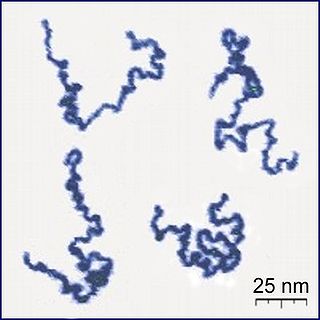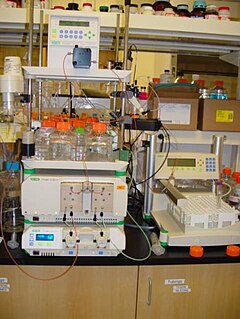
In chemistry, a colloid is a mixture in which one substance of microscopically dispersed insoluble or soluble particles is suspended throughout another substance. Sometimes the dispersed substance alone is called the colloid; the term colloidal suspension refers unambiguously to the overall mixture. Unlike a solution, whose solute and solvent constitute only one phase, a colloid has a dispersed phase and a continuous phase that arise by phase separation. To qualify as a colloid, the mixture must be one that does not settle or would take a very long time to settle appreciably.

A polymer is a large molecule, or macromolecule, composed of many repeated subunits. Due to their broad range of properties, both synthetic and natural polymers play essential and ubiquitous roles in everyday life. Polymers range from familiar synthetic plastics such as polystyrene to natural biopolymers such as DNA and proteins that are fundamental to biological structure and function. Polymers, both natural and synthetic, are created via polymerization of many small molecules, known as monomers. Their consequently large molecular mass, relative to small molecule compounds, produces unique physical properties including toughness, viscoelasticity, and a tendency to form glasses and semicrystalline structures rather than crystals. The terms polymer and resin are often synonymous with plastic.
Radius of gyration or gyradius of a body about an axis of rotation is defined as the radial distance to a point which would have a moment of inertia the same as the body's actual distribution of mass, if the total mass of the body were concentrated.

Size-exclusion chromatography (SEC), also known as molecular sieve chromatography, is a chromatographic method in which molecules in solution are separated by their size, and in some cases molecular weight. It is usually applied to large molecules or macromolecular complexes such as proteins and industrial polymers. Typically, when an aqueous solution is used to transport the sample through the column, the technique is known as gel-filtration chromatography, versus the name gel permeation chromatography, which is used when an organic solvent is used as a mobile phase. The chromatography column is packed with fine, porous beads which are composed of dextran polymers (Sephadex), agarose (Sepharose), or polyacrylamide. The pore sizes of these beads are used to estimate the dimensions of macromolecules. SEC is a widely used polymer characterization method because of its ability to provide good molar mass distribution (Mw) results for polymers.
Polymer physics is the field of physics that studies polymers, their fluctuations, mechanical properties, as well as the kinetics of reactions involving degradation and polymerisation of polymers and monomers respectively.
In physics, an entropic force acting in a system is an emergent phenomenon resulting from the entire system's statistical tendency to increase its entropy, rather than from a particular underlying force on the atomic scale. The entropic force can be considered as an emergent of the entropic interaction. The concept of entropic interaction was usually used in a subjunctive mood. For example: "macromolecule links, as if, entropically repulse from each other at a short distance and entropically are attracted to each other at a long distance”. In a modern view the entropic interaction is considered to be a real-life interaction, and it is viewed as a mutual influence of open thermodynamic systems on each other by means of transferring information about their states, changing their entropies and translation of these systems into more probable conditions. The entropic interaction is a quintessential physical interaction that is realized by well-known basic interactions through the processes that occur elsewhere in the universe including the solar system, our planet Earth, and living organisms. The basic interactions are considered to be daughter of the entropic interaction. The entropic interaction is not a consequence of existence of some entropy charge and a field accompanying it. It should not be referred to as a distribution of the entropy in the space. Entropy interaction reflects only an “order” and “structure” of the space, the state of the space and physical systems in it and, ultimately, affects the energy, behavior and evolution of such systems as well as the space as a whole. The entropic interaction results in the alteration of symmetry, free energy, and other characteristics of the physical system. Using this interaction, all material objects in Nature exert a certain influence on each other, regardless of the distance between them.

In polymer chemistry, branching occurs by the replacement of a substituent, e.g., a hydrogen atom, on a monomer subunit, by another covalently bonded chain of that polymer; or, in the case of a graft copolymer, by a chain of another type. Branched polymers have more compact and symmetrical molecular conformations, and exhibit intra-heterogeneous dynamical behavior with respect to the unbranched polymers. In crosslinking rubber by vulcanization, short sulfur branches link polyisoprene chains into a multiply branched thermosetting elastomer. Rubber can also be so completely vulcanized that it becomes a rigid solid, so hard it can be used as the bit in a smoking pipe. Polycarbonate chains can be crosslinked to form the hardest, most impact-resistant thermosetting plastic, used in safety glasses.
The hydrodynamic radius of a macromolecule or colloid particle is . The macromolecule or colloid particle is a collection of subparticles. This is done most commonly for polymers; the subparticles would then be the units of the polymer. is defined by

Reptation is the thermal motion of very long linear, entangled macromolecules in polymer melts or concentrated polymer solutions. Derived from the word reptile, reptation suggests the movement of entangled polymer chains as being analogous to snakes slithering through one another. Pierre-Gilles de Gennes introduced the concept of reptation into polymer physics in 1971 to explain the dependence of the mobility of a macromolecule on its length. Reptation is used as a mechanism to explain viscous flow in an amorphous polymer. Sir Sam Edwards and Masao Doi later refined reptation theory. Similar phenomena also occur in proteins.
In a polymer solution, a theta solvent is a solvent in which polymer coils act like ideal chains, assuming exactly their random walk coil dimensions. Therefore, the Mark–Houwink equation exponent is in a theta solvent. Thermodynamically, the excess chemical potential of mixing between a polymer and a theta solvent is zero.

In the physical chemistry study of polymers, the end-to-end vector is the vector that points from one end of a polymer to the other end.

Vladimir E. Korepin is a professor at the C. N. Yang Institute of Theoretical Physics of the Stony Brook University. Korepin contributed in several areas of mathematics and physics.
Crystallization of polymers is a process associated with partial alignment of their molecular chains. These chains fold together and form ordered regions called lamellae, which compose larger spheroidal structures named spherulites. Polymers can crystallize upon cooling from melting, mechanical stretching or solvent evaporation. Crystallization affects optical, mechanical, thermal and chemical properties of the polymer. The degree of crystallinity is estimated by different analytical methods and it typically ranges between 10 and 80%, with crystallized polymers often called "semi-crystalline". The properties of semi-crystalline polymers are determined not only by the degree of crystallinity, but also by the size and orientation of the molecular chains.
In polymer physics, the coil–globule transition is the collapse of a macromolecule from an expanded coil state through an ideal coil state to a collapsed globule state, or vice versa. The coil–globule transition is of importance in biology due to the presence of coil-globule transitions in biological macromolecules such as proteins and DNA. It is also analogous with the swelling behavior of a crosslinked polymer gel and is thus of interest in biomedical engineering for controlled drug delivery. A particularly prominent example of a polymer possessing a coil-globule transition of interest in this area is that of Poly(N-isopropylacrylamide)(PNIPAAm).

The Rouse model is frequently used in polymer physics.
Flory function
Synonym: viscosity function, , SI unit: mol-1
Polymer architecture in polymer science relates to the way branching leads to a deviation from a strictly linear polymer chain. Branching may occur randomly or reactions may be designed so that specific architectures are targeted. It is an important microstructural feature. A polymer's architecture affects many of its physical properties including solution viscosity, melt viscosity, solubility in various solvents, glass transition temperature and the size of individual polymer coils in solution.

A polymer is a macromolecule, composed of many similar or identical repeated subunits. Polymers are common in, but not limited to, organic media. They range from familiar synthetic plastics to natural biopolymers such as DNA and proteins. Their unique elongated molecular structure produces unique physical properties, including toughness, viscoelasticity, and a tendency to form glasses and semicrystalline structures. The modern concept of polymers as covalently bonded macromolecular structures was proposed in 1920 by Hermann Staudinger. One sub-field in the study of polymers is polymer physics. As a part of soft matter studies, Polymer physics concerns itself with the study of mechanical properties and focuses on the perspective of condensed matter physics.
Polymerscattering experiments are one of the main scientific methods used in chemistry, physics and other sciences to study the characteristics of polymeric systems: solutions, gels, compounds and more. As in most scattering experiments, it involves subjecting a polymeric sample to incident particles, and studying the characteristics of the scattered particles: angular distribution, intensity polarization and so on. This method is quite simple and straightforward, and does not require special manipulations of the samples which may alter their properties, and hence compromise exact results.
The unified scattering function was proposed in 1995 as a universal approach to describe small-angle X-ray, and neutron scattering from disordered systems that display hierarchical structure.









